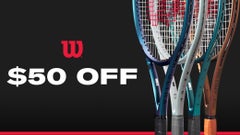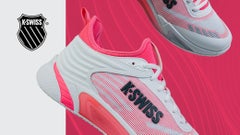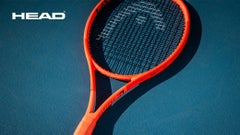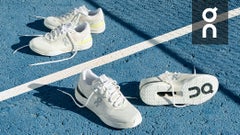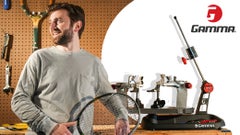When to Replace Your Tennis Shoes
When it comes to your tennis shoes wearing out, there are a lot of factors that can determine when it’s time to replace them. It's easy to spot if you wear through the rubber outsoles, but holes on the bottom of your shoes are not the only reason you should replace your tennis shoes. Our product experts have years of playing experience and helping customers find the right equipment, and we’re sharing some information on how your tennis shoes will break down over time, and why it is important to replace them when they no longer are helping you to perform at your best.

Visual Signs of Worn Out Shoes
When it comes to the durability of your tennis shoes, there are some obvious signs that they have worn out and need to be replaced. For some players who spend a lot of time on the court, for example: players who are on a competitive team, league team players, developing juniors who train at a club or academy or just the recreational player who puts in a lot of court time. Usually these players will end up wearing a hole somewhere on their tennis shoes, especially when playing on hard courts.


The most common wear zone is the outsole, and specifically the forefoot and toe region where most players are putting pressure when they move on the court. When the outsole rubber has completely worn out, it is usually something that you can tell by looking at or inspecting; the layer underneath (midsole) appears as a foam layer. This is usually one major sign to go shopping for a new pair of shoes (at Tennis Warehouse of course) because the midsole layer is not made for gripping the court and protecting your feet from abrasion like the rubber outsole does.
Furthermore, the midsole layer is not necessarily made to be non-marking like the rubber outsole; it may cause you to start marking up the courts, and that is not a good thing. Especially if you are a member of a private club, you may be asked to leave and get some new tennis shoes. There is also a trend of players wearing holes in the upper of their tennis shoes, typically players who slide on hard courts. During the slide, the back foot will typically turn over and the medial side of the upper gets scraped on the hard court surface, burning a hole in the upper and sometimes shredding the laces. This type of wear is less common and is only experienced by certain players who can execute a hard court slide, but it is something that will cause tennis shoes to wear out quickly.
Pro Tip: If you are a player who wears through the rubber outsole on your tennis shoes, we suggest checking out the shoes on our website that are backed by an outsole durability guarantee. The shoes that are in this category, come backed by a six-month warranty that is specific to the rubber outsole (not other parts of the shoes). If the rubber outsole wears through all the way to the midsole layer, within six months of the invoice date, you may return the shoes to Tennis Warehouse for a one-time replacement. This is definitely something to consider when purchasing new tennis shoes from Tennis Warehouse (some of the warranties are exclusive to TW) if you are a player that puts in a lot of hours on court, and puts a lot of wear and tear to the outsole.
Wear You Can't See but Can Feel
Beyond some of the telltale signs of your tennis shoes needing to be replaced, such as wearing holes in the outsole or the upper material of the shoes, there are other signs to be aware of. Not all of us tennis players will wear holes in their shoes, and there are other parts of our tennis shoes that can wear down, start to cause discomfort and take away from our ability to perform optimally. First and foremost, is the cushioning of the shoes located in the midsole. This is something that can be somewhat hard to tell just by the looking at the shoes, but you can typically feel it over time. When shoes are fresh, the midsole cushioning (the material located underneath the insoles, but on top of the rubber outsole) should help to absorb some of the shock and reduce the feeling of impact between your body and the court. This is an important factor no matter what court surface you are playing on, but especially on hard courts. As time goes on and you have put a lot of hours into wearing your shoes, the midsole foam will start to break down and lose some of its resiliency. The foam will start to compress and will no longer bounce back or rebound, and at this point you will be losing out on the cushion, shock absorption and the padding that helps soften the impact on your body and joints.

Another factor to consider is the support level, and how well the shoes secure your feet; often times we refer to it as the “lock-down.” The upper materials of your tennis shoes, usually a synthetic leather, mesh, TPU or a combination of those materials, will start to loosen up and stretch out. Over time, the upper material will stretch out to the point where it no longer holds your feet in place, or provides that “lock-down” type of support. This can cause you to lose confidence in your movement, especially side to side like in a baseline rally. When the upper material stretches and starts to balloon out over the foundation of the shoe, this can be an issue in terms of the lateral support (or lack there of); worst case scenario it could increase your chance of injury or lead to an ankle roll. Another design feature that is built into most tennis shoes is the mid-foot shank, which is meant to create stability and rigidity in the foundation of the shoes (think about it like the chassis of a car). This part of the shoe will usually hold up longer than the cushioning and the upper materials, but after a lot of use, even the shank and the foundation of the shoes will start to soften up. At this point the shoes will no longer provide the level of torsional stability that they were designed for, which can lead to having less confidence in your movement on court (specifically quick changes in direction), and this could also increase the risk of injury.
Pro tip: To help extend the life of your tennis shoes, try not to wear them all day for casual wear. The more you wear them, the more it will put stress on the materials of your shoes; especially the midsole cushioning, compressing it and shortening its lifespan. Try to keep your tennis shoes for wearing and playing specifically on the court. So when you are done playing tennis, we recommend changing out of your tennis shoes for your daily casual wear shoes, or if you really want to treat your feet you might consider a nice pair of recovery slides or sandals.
Final Thoughts
To sum things up, some players will burn through the rubber outsoles on their shoes; depending on their playing level and time spent on court, this can happen rather quickly as well. For high level players and youngsters who slide on hard courts, you will often times see a whole worn through the upper of the shoes as well. These are pretty obvious signs that you should replace your tennis shoes. With that said, not all of us are burning holes in the rubber outsoles or sliding on hard courts like the speedy players we watch on TV. After many hours of wear on the tennis court, your shoes will start to break down, losing some of the cushioning and the overall level of support and stability. To keep you moving at your best level, and to minimize your risk of injury, we recommend replacing your tennis shoes even if there aren’t the obvious signs, like holes worn through the uppers and outsoles. As a rule of thumb, we think that replacing your tennis shoes twice a year or bi-annually is a good starting point, even without the holes worn through. If you want to treat yourself, keeping you looking fresh and feeling fresh, maybe consider replacing your tennis shoes three to four times a year; sort of think of it as a quarterly treat for your style and your feet!


